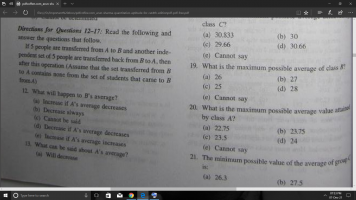There are 3 classes having 20, 25 and 30 students respectively having average marks in
an examination as 20,25 and 30 respectively. The three classes are represented by A, B and C and you have the following information about the three classes.
a. In class A highest score is 22 and lowest score is 18
b. In class B highest score is 31 and lowest score is 23
c. In class C highest score is 33 and lowest score is 26
If five students are transferred from A to B, what can be said about the max possible average score of class B ?
No of students B has = 30 where 5 is from class A
Sum of the marks of each student of class B = 25 original students of class B * marks1 + 5 students from class A * marks2
marks2 will be 22 as the five students have already inherited the highest score of class A and then came to class B.
As highest score can be inherited by only one person but bcoz 22 is the highest score of class A not of B that why multiple students which in this case is 5 are obtaining multiple 22' s.
but what will be marks1 ? i guess 25 marks as 25 students of class B cannot obtain class B highest score i.e 31 .
an examination as 20,25 and 30 respectively. The three classes are represented by A, B and C and you have the following information about the three classes.
a. In class A highest score is 22 and lowest score is 18
b. In class B highest score is 31 and lowest score is 23
c. In class C highest score is 33 and lowest score is 26
If five students are transferred from A to B, what can be said about the max possible average score of class B ?
No of students B has = 30 where 5 is from class A
Sum of the marks of each student of class B = 25 original students of class B * marks1 + 5 students from class A * marks2
marks2 will be 22 as the five students have already inherited the highest score of class A and then came to class B.
As highest score can be inherited by only one person but bcoz 22 is the highest score of class A not of B that why multiple students which in this case is 5 are obtaining multiple 22' s.
but what will be marks1 ? i guess 25 marks as 25 students of class B cannot obtain class B highest score i.e 31 .
Last edited:

